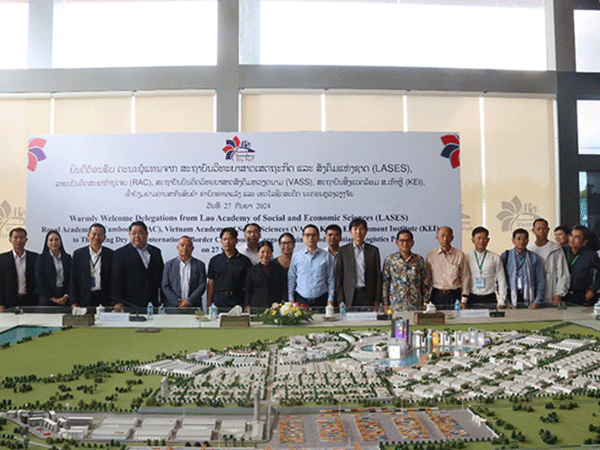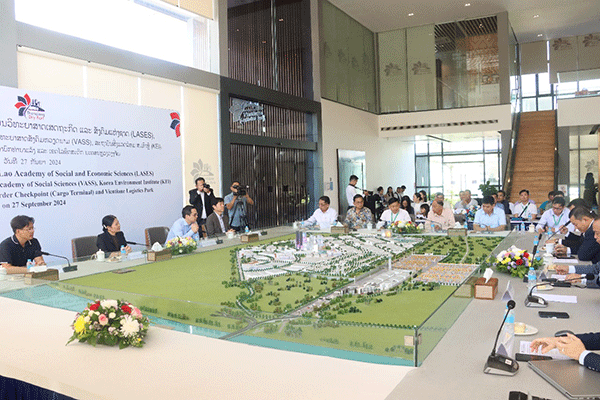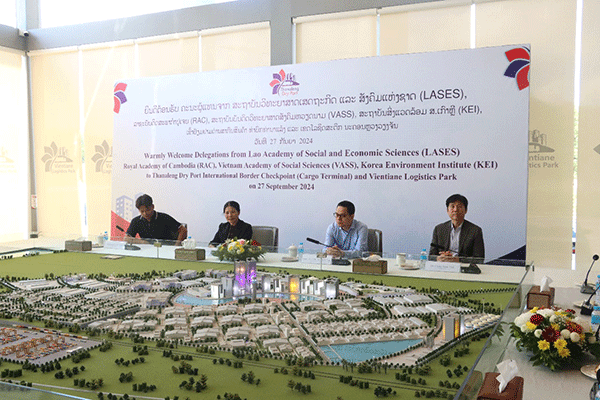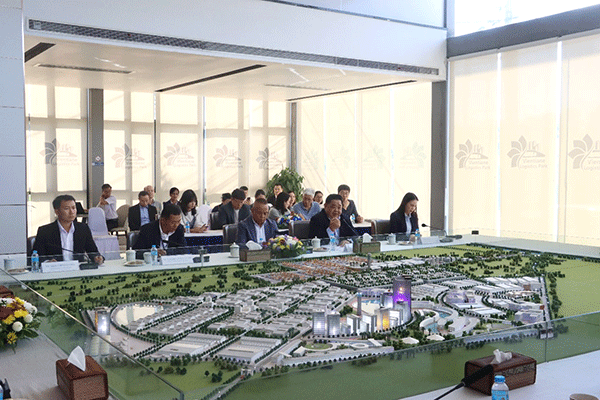 |
| Mr Tee Chee Seng (fourth left), Mr Sakhone Philangam (fifth left) and representatives from all sides gather for a group photo at the Thanaleng Dry Port Office. |
Laos set to become regional logistics connector, offering ‘great opportunities’
As the Belt and Road Initiative (BRI) advances, investors say that Laos and its links to regional and global centres and supply chains are strengthening, boosting opportunities to be a core logistics connector.
 |
The developers of Laos’ first integrated logistics centre recently welcomed foreign delegates from Cambodia, Vietnam and South Korea to Thanaleng Dry Port and its associated Vientiane Logistics Park to explain how Laos has become an important logistics connector.
The opening of the Laos-China railway in 2021, a flagship BRI project, has transformed landlocked Laos into a land-linked country, connecting Southeast Asia to China and Europe.
“It is the new connectivity from ASEAN to China and Europe,” Vice President of Vientiane Logistics Park Co., Ltd., Tee Chee Seng told the guests.
The visiting delegation included representatives from the Lao Academy of Social and Economic Science, the Royal Academy of Cambodia, the Vietnam Academy of Social Science, and the Korea Environment Institute.
To facilitate cross-border rail transport and add value to the improved connectivity, the Lao investors have partnered with the government to build the dry port and logistics park, which opened for services the day after the opening of the railway.
Functioning as the cargo terminal, the dry
 |
port provides single-window customs clearance for rail transport. It also houses a container yard, where the standard-gauge Laos-China railway and one-metre-gauge Laos-Thailand railway have been built in parallel, enabling seamless rail transport.
Thanks to this convenience, the historic ASEAN Express - a freight train system linking Malaysia to Thailand, Laos and Chongqing in China - completed its first round trip in July, taking just nine days for a one-way journey compared to 14 to 21 days by sea, resulting in approximately 20 percent cost savings, underscoring a promising new trade route.
From China, cargo could continue to Kazakhstan, Russia, Belarus, Poland and even Duisburg in Germany. It takes just 14-21 days from Southeast Asia to Europe by rail, compared to 45 days by sea.
Though shipping through the sea route is typically cheaper, TDP Managing Director Sakhone Philangam raised that rail transport could be the best option for shipment of certain groups of products, such as fashion goods that need quicker shipment to hit market shelves on time to catch up with trends, and high-end products that need the highest guarantee for transport safety.
Products that need to meet demand quickly in certain markets that face shortages are also potential areas for rail shipment to fill a need.
In 2022, the dry port handled 49,183 containers, of which 36,768 were destined for import and export, while 12,415 containers were in transit. The containers were shipped to countries such as Thailand, Vietnam, Cambodia, Myanmar, Malaysia, Singapore, China, Russia and other European markets. The dry port has recorded a container volume increase of between 30-40 percent year on year.
 |
In response to questions from interested delegates, Mr Tee Chee Seng expressed that his company envisions facilitating rail freight transport with Cambodia through Thailand’s rail network, saying that the current cross-border rail system already reaches Cambodia.
To make that vision come true, all stakeholders must get together for talks and reach a consensus on cross-border procedures to facilitate rail transport, Mr Tee Chee Seng told Vientiane Times.
Through the dry port, containers have already reached Cambodia and Vietnam by road, he added.
To enhance logistics and transport networks, Laos is set to host an International Symposium on ASEAN Logistics Connectivity, and the first Laos Logistics Fair 2024, scheduled to take place on October 10-11 in Vientiane.
The two events coincide with the ASEAN Business and Investment Summit (ABIS) 2024, which will be held back-to-back with the ASEAN summit, set to take place on October 8-11 in Laos, the Chair of ASEAN for 2024.
Stakeholders from across ASEAN and the rest of the world will discuss strategies for enhancing logistics and transport networks in the region.
After the symposium, recommendations would be made and submitted to the governments involved, according to Mr Sakhone.
Improved connectivity has offered great opportunities not only for trade, but also investment.
To tap these opportunities, the Lao investor is developing a logistics park on 327 hectares of land near the first Mekong Friendship Bridge, which connects Laos and Thailand. The US$547 million project includes a plant and animal quarantine facility, a tank farm, an export processing zone, a logistics park, a free trade zone, a technology hub, and a gold extraction and processing plant.
Some zones could be opened to welcome investors sometime next year, according to Mr Tee Chee Seng.
Manufacturers in Laos will enjoy several incentives, such as tax breaks and privileged access to major markets in countries that provide exemptions or reductions of import tariffs on goods made in Laos. Approximately 42 countries and territories extend such special treatment to Laos.
ByAdvertorial Desk
(Latest Update September 30, 2024)
|





